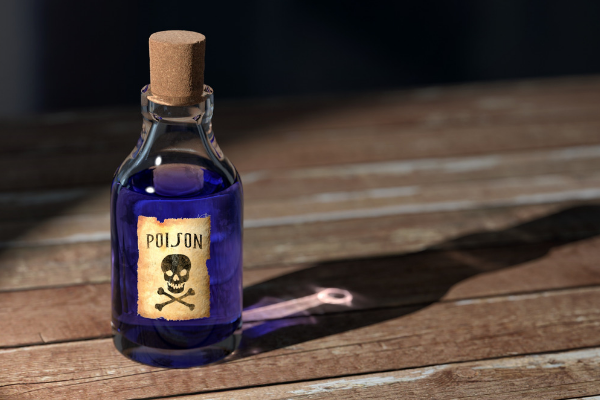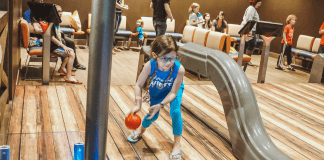Poison Prevention Week, held during the third week of March, reminds us that some of the deadliest and most dangerous items in our homes are hiding in plain sight. Just take a peek under your kitchen sink or in your laundry room. And don’t forget to have a look inside your medicine cabinet. Household cleaners, prescription medications, pesticides, and other items can pose serious hazards to the health and well-being of our families and even our pets.
About 30 children die every year from being poisoned by common household items, according to the Consumer Product Safety Commission. The Consumer Product Safety Commission also reports that accidental poisoning accounts for more than 2 million calls each year to poison control centers and more than 80,000 visits to the emergency room. National Poison Prevention Week contributed to an 80 percent reduction in poison-related deaths since the early 1970s.
 Think of it this way; You took the steps to baby-proof your house, and you always make sure to turn off your stove and hair curler before leaving the house. But those are the obvious threats. What is of more concern, are the many seemingly harmless items all over your house that have the potential to be seriously dangerous. Beware of the following:
Think of it this way; You took the steps to baby-proof your house, and you always make sure to turn off your stove and hair curler before leaving the house. But those are the obvious threats. What is of more concern, are the many seemingly harmless items all over your house that have the potential to be seriously dangerous. Beware of the following:
Household Plants
Popular varieties like daffodils, iris, lily-of-the-valley, ivy, and even mistletoe are poisonous when consumed, according to the National Capital Poison Center. They contain toxins or dangerous chemicals to protect themselves from insects, animals—and yes, even humans. So play it safe and keep them out of your home if you have curious pets or kiddos (and that’s just about all of us)!
Carbon Monoxide
Of course, we are all well versed in the dangers of carbon monoxide poisoning. It’s a serious risk—it’s the leading cause of poisoning death, says the Centers for Disease Control and Prevention (CDC). Carbon monoxide comes from some pretty common items:
- Gas Oven
- Car
- Space Heater
- Charcoal Grill
Carbon monoxide (CO) is a colorless, odorless gas that causes sudden illness or death, and is often detected when it’s too late. Play it safe and install a CO monitor in your home so you’re alerted if levels are getting dangerously high.
Toothpaste
I know what you’re thinking…TOOTHPASTE, seriously? Well, the warning is right there on the label: “Seek immediate medical help if you ingest toothpaste.” If you consume too much, the overdose can cause stomach pain and intestinal blockage. But if the toothpaste contains fluoride, as most do these days, it gets far more serious—convulsions, difficulty breathing, and heart attack (amongst other scary side effects), according to Medline Plus.
Of course, I’m not suggesting that we should avoid toothpaste (YUCK!), but just keep an eye kids and make sure they are using the correct pea-sized amount, and rinsing with each brush.
Mothballs
Did you know that mothballs pose a serious threat to household safety? They are a serious risk at home, primarily toward young children. The active ingredient may be either naphthalene or paradichlorobenzene (big scary words). Each active ingredient can cause different health effects if the exposure is high enough.
When you smell mothballs, you are inhaling the insecticide. Babies have a lesser ability to clear this by-product of mothballs from their bloodstreams. As a result, of the approximately 4,000 children exposed to mothballs each year, 600 require immediate medical attention. Jaundice, the yellowing of the skin, is a key symptom that can lead to organ failure and even death.
Furniture Polish
Furniture polish can make your furniture look brand-new and give your home a subtle new light. But it can also cause a trip to the emergency room. Although it’s a common item found under the kitchen sink in homes across the world, furniture polish possesses an extremely toxic composition.
MedlinePlus, reports that the hydrocarbons within liquid furniture polish are likely to poison the body when swallowed or even inhaled. The compound presents numerous risks to several body parts:
- If it reaches your eyes, it can cause vision loss.
- If inhaled, it can cause serious lung damage.
- If you have further skin contact, it can cause severe irritation.
Furniture polish is simply not worth having around the house to give your wood a little extra shine, particularly if children are present.
Button Batteries
Be especially mindful of the 20 mm lithium coin cell. When swallowed by children, especially those younger than 4 years, it often lodges in the esophagus causing burns within just 2 hours. A hole in the esophagus may develop and the burn can extend into the trachea or aorta.
More than 40 children have died from swallowing button batteries.
Iron Pills
Adult-strength iron pills are very dangerous for children to swallow. Children can start throwing up blood or having bloody diarrhea in less than an hour.
Topical Anesthetics
These medicines can cause seizures or a condition called methemoglobinemia which keeps the blood from carrying oxygen to the tissues. Be especially careful with teething gels, hemorrhoid preparations, anti-itch creams, and sunburn relief agents.
Nail Glue Remover and Nail Primer
Some products used for artificial nails can be poisonous in surprising ways. Some nail glue removers have caused cyanide poisoning when swallowed by children. Some nail primers have caused burns to the skin and mouth of children who tried to drink them.
Windshield Washer Solution and Antifreeze
Small amounts of these liquids are poisonous to humans and pets. Windshield washer solution can cause blindness and death if swallowed. Antifreeze can cause kidney failure and death if swallowed.

How to Observe Poison Prevention Week
- Memorize the Poison Control helpline phone number
It’s easy to remember: 1-800-222-1222. Save it on your phone. And make sure to place the number where others can easily find it. (The kitchen fridge is a good place.) - Poison-proof your home
There are plenty of resources out there with handy lists of ways to poison proof your home. The government’s Health Resources and Services Administration is an excellent place to start. - Spread the word
Tell your families, neighbors, and coworkers about poisons and how to keep themselves safe. This can be done in emails, memos, or in groups set up for this purpose on social media.












